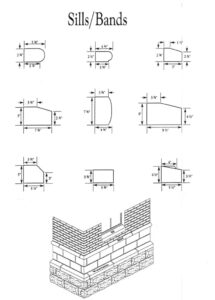Keystones made of limestone are essential to the construction field because they provide both aesthetic appeal and structural integrity. However, making sure they work requires close attention to detail.
In this blog, we will discuss common mistakes to avoid in limestone keystones specifications, emphasizing the need for careful study, professional advice, and accuracy. For best results, every detail needs to be carefully examined, from taking the environment into account to precise measurement and sizing. Let’s see how averting these typical blunders improves the longevity and success of limestone keystone installations.
1. Lack of Proper Research
Ignorance of appropriate research is one of the most common errors in limestone keystone requirements. Inadequate research into the qualities and traits of limestone bands can lead to ignoring essential elements like weather resistance, longevity, and aesthetic appeal. Construction professionals may ensure the project’s longevity and functionality by completing a thorough study of the various forms of limestone that are available and how well they perform in multiple conditions.

2. Ignoring Environmental Factors
Another huge error is neglecting environmental considerations when selecting limestone keystones. Because limestone is prone to moisture and erosion, it is important to take climate, exposure to the elements, and geographic location into account. If these environmental influences are not taken into consideration, the limestone keystones may deteriorate earlier than expected, endangering the overall construction’s structural integrity. Construction experts can increase the project’s longevity and performance by choosing limestone types that are appropriate for particular environmental circumstances, such as those resistant to moisture or frost.
3. Failure to Consult Experts
Expert advice is essential regarding limestone keystone specifications. Architects, engineers, and limestone specialists are useful resources for guaranteeing that specifications fulfill project needs and helping to prevent frequent mistakes. Construction professionals can address possible issues, optimize design options, and ultimately achieve superior results by consulting experts early in the specification process.
4. Inaccurate Measurement and Sizing
When it comes to building, mismeasured and oversized limestone keystones can cause serious problems. The project’s structural integrity may be jeopardized by gaps or instability caused by missized keystones that need to fit correctly. Measurement errors also result in unnecessary material waste and higher expenses. Construction teams may guarantee accurate measurement and sizing of limestone keystones, reducing errors and optimizing productivity by hiring trained personnel and making use of cutting-edge measurement equipment.
5. Neglecting Maintenance Considerations
Last but not least, a common error in limestone keystone requirements is overlooking maintenance concerns. Even though limestone is solid and long-lasting, it needs regular maintenance to maintain both its functionality and look throughout time. Staining, erosion, and other problems that compromise the project’s structural integrity and aesthetic appeal might arise from neglecting maintenance requirements, which include sealing, cleaning, and recurring inspections. Building professionals can increase the durability and aesthetic appeal of limestone installations by including maintenance concerns in limestone keystone requirements.
Get Accurate Limestone Keystone Specification By Avoiding Such Mistakes
In conclusion, avoiding common mistakes in limestone keystone specifications is critical to the success of building projects. By conducting extensive research, taking into account the effects of the environment, working with experts, taking accurate measurements, and planning for maintenance, construction professionals can reduce risks and achieve unmatched results.
Limestone keystones, when installed with precision and in accordance with industry guidelines, can enhance the visual attractiveness of any building project while strengthening its structural durability. The use of limestone bands can improve the overall quality and lifespan of building projects by leaving a lasting image of dependability and craftsmanship, provided that there is a solid dedication to excellence and a keen focus on best practices.